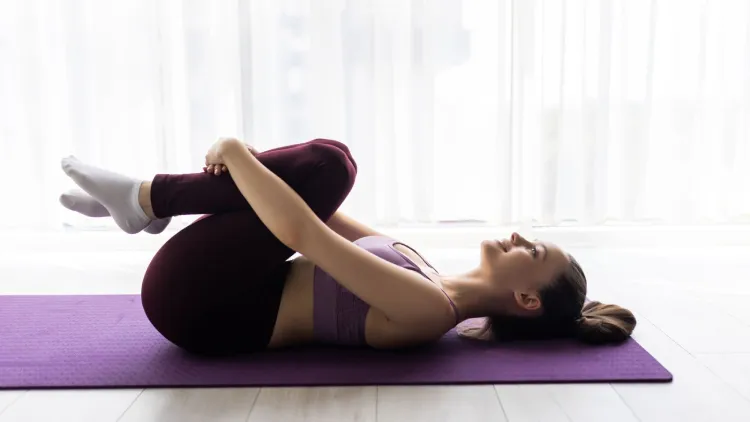Pain during a stomach stretch is not pleasant, and, actually, not very alarming. The pain that causes stretching, whether mild or sharp cramping, stretching pain in stomach may be due to several factors that include straining muscles, gas/bloating, poor posture, or some other severe complications like the occurrence of hernias or even stomach problems.
Although in most situations the pain resolves itself quite easily and it is related to overexertion or poor technique, one should be aware of the symptoms that might indicate the necessity of medical attention. The present paper examines the potential triggers, the most popular symptoms, and the solutions that may help to address and resolve the problem of stretching pain in stomach, as well as some prevention strategies and red flags indicating that the patient needs professional services.
Knowing these main points will enable you to deal with the pain safely and carry on with the stretching with no fear of harming yourself. Some of its stretches are related to stretching for back.

What Is Stretching Pain in the Stomach?
Stretching pain in stomach simply means any form of discomfort, cramping or sharp sensation that one experiences in the abdominal region when the body is in a bent or stretchy position. This discomfort could be experienced when doing yoga practice, belly workouts or even in the morning when you perform some basic exercises.
Depending upon the occasion, it may result in a drawing sensation, a burning pain or local cramping.
This pain may either be temporary or chronic. And in some circumstances, you can find that when you move, it feels worse, and when you rest, it feels good, and in other circumstances, it may stick around with you no matter what you do. Although it gets correlated with muscle strain or diarrhoea, one should not disregard the stretching pain in stomach, especially when it is recurrent or becomes more intense over a period of time.

Common Causes of Stretching Pain in the Stomach
The reason why an individual may feel stretching pain in the stomach can be varied, going all the way to serious medical issues to mere minor concerns. The most common causes can be found below:
1. Tear or Strain of the Muscle
Numerous exercises involving stretch, such as core exercises, involve the engagement of abdominal muscles. Pain in a muscle is possible as a result of overstress or incorrect position, causing a tear or strain. You can either feel tenderness in the region when you touch it, or you may experience a sharp pain when you are moving.
2. Physical Activity that Goes Beyond What One Can Handle
Stretching pain in stomach can be the result of pushing your body hard, particularly in an exercise session that involves the muscles of the core or lower body. This kind of discomfort is most likely to be experienced by beginners who lack core strength.
3. Bloated, Indigestion or Gas
Trapped gas or bloating is one of the non-threatening causes of stretching pain in the stomach. The digestive organs can be strained by stretching, and hence, the area becomes tight or painful. Such symptoms run their course and go away by themselves, although some foods and eating habits may aggravate them.
4. Wrong Stretching Posture
Inappropriate execution in stretching workouts may cause imbalance and disparity in the stomach area. This can even bring pain, particularly in the lower or side parts of the stomach. This is best avoided by doing stretches slowly at all times and with the right guidance to perform them.
5. Abdominal Hernia
Hernia occurs when one of the organs or tissues inside the body extends through a defect in the wall of the abdomen. It can result in an apparent bulging and burning pain of the stomach, particularly when a person moves. Most of the time, lifting, straining, or stretching activities exacerbate the problem of the hernia and hernias are normally treated medically.
6. Menstrual-Related Cramps
The stretching pain in stomach could be related to menstrual cramps in the female body, particularly in the lower region. This pain may be compounded by the stretching of some of the muscles during menstruation. It is usually due to hormonal changes and contractions in the uterus.
7. Gastrointestinal Issues
Such situations as the IBS (Irritable Bowel Syndrome), constipation, or acid hyperemesis can cause discomfort, which can be enhanced with tumbling or abdominal crush. If your stomach is sore to stretch and is interspersed by digestive problems, you may desire to consider GI explanations.
8. Scar Tissue / Adhesions
Individuals with experience in abdominal surgeries present the risk of developing adhesions in the form of bands of scar tissue which attach organs. They may at times result in a feeling of stretching pain in stomach when the region is moved or stretched.
Symptoms to Watch For
The symptoms differ with the cause of the stretching pain in the stomach, in case you experience pain. The most frequent signs are the following:
- Abrupt or acute abdominal pain during stretch
- Tightness of the core muscles or cramping
- Radiating pain in the sides or lower back
- Puffiness on the head and stomach, tenderness on the stomach on pressing it.
- Obvious protrusion or distension (e.g. hernias)
- Bloating or alterations in bowel habits, nausea
- Doubling of pain as a result of bending or twisting of muscles
Knowledge of the traits of the pain could enable you or your doctor to determine whether it is muscle pain or it is associated with an internal problem.

How to Relieve Stretching Pain in the Stomach
In case you have stretching pain in stomach, there are a few tips to deal with the discomfort and promote the healing process. The proper treatment is dependent on the nature and reason of the resulting pain.
1. Stop the Activity
In case you experience unusual or sharp pain during a stretch, cease straightway. Further exercise can aggravate a muscle tear or hernia.
2. Take a Cold or Hot Compress
Tight abdominal muscles could be relaxed with a warm compress, and in some cases of cramps, can also be eased. To decrease inflammation, a cold pack may be used in case of acute strain or injury.
3. Move with Tenderness
Whether it is gas or bloating, walking slowly or doing light yoga will alleviate the pain. One should avoid any twisting or deep core stretches until the pain goes away.
4. Keep Yourself Hydrated and Change Your Diet
Stretching pain in stomach is usually caused by bloating and indigestion. Consume a lot of fluids, and avoid consuming food that causes gas, such as beans, carbonated drinks, or heavy foods, before exercise.
5. Take Over-the-Counter Medicines
The pain, when mild and due to cramping, bloating or straining, can be treated by antacids, simethicone (to treat gas), or pain relievers. Nevertheless, one should never overuse and follow the instructions.
6. Get Your Technique Right
Most of the incidences of pain in the stomach are brought about by poor form. Find out how to make the right form during each stretch, and involve the core body safely. Otherwise, one can take a one-on-one with a certified fitness practitioner or physical therapist.

When to Seek Medical Help
Most reasons leading to stretching pain in the stomach are somehow tame and disappear after rest or treatment; nevertheless, certain circumstances demand emergency treatment. Ask someone to help you in case:
- You have severe or acute pain in the abdomen
- A bulge can be seen, and this can be an indication of a hernia
- Pain is either accompanied by fever, nausea or vomiting
- You find trouble in standing or walking
- The soreness does not confine itself to lasting a few days or recurring again and again
- You have abdominal bloating, and it has not moved your bowels for a couple of days
The postponing of treatment might cause complications, particularly when there is a hernia, appendicitis, or blockage within the gastrointestinal system.
Preventing Stretching Pain in the Stomach
The combination of the right stretching methods, good posture and the lifestyle is what should help in the prevention of stomach stretching pain. These are a few tips:
- Warm Up: Prepare before stretching with light cardio or dynamic exercise to improve the flow of blood.
- Stretch Gently: Do not force a stretch. Proceed slowly and take a 20-30 second stretch without bouncing.
- Stay Strong: Core strength supports abdominal muscles and lowers the chance of getting hurt.
- Do not eat Heavily Before Exercise: You may consume light foods and give your bowel time to digest before stretching or exercising.
- Good Posture: When exercising or sitting, it is helpful to maintain a good posture as this avoids unwarranted abdominal strain.
- Hydrate Properly: Dehydration may predispose one to cramping and straining of the muscles.
- Pay attention to Your Body: Pain is an indication. Never disregard pain when stretching or power through the pain.

Final Thoughts
The stomach can cause you some pain that will be mostly due to stretching, and you may feel anxious upon experiencing a stretching pain in stomach. To most individuals, it is either because of strain on muscles, digestive disorders, or not applying the method well. Yet, it may also be related to such serious illnesses as hernias or digestive disorders.
By listening to your body, deploying proper techniques of stretching and ensuring abdominal health, you will be able to minimise the potential of causing any form of pain and keep reaping the numerous benefits of stretching. Never forget to consult a health specialist in case your condition does not improve or it becomes aggravated.
Frequently Asked Questions
1. Does stomach stretching pain cause any severe conditions?
In most cases, it is not so serious. It is mostly due to muscle strain or gas. However, when the pain is sharp, persistent, or otherwise accompanied by other symptoms, consult the doctor.
2. What must I not do when I experience stomach pain while stretching?
Do not perform deep stretches, eat a large meal before physical activity, or have bad posture. Sleep and relax.
3. Is it possible that gas or bloating leads to the pain of stretching of the stomach?
Yes, gas bloating may give you pain in the stomach as you stretch. It tends to disappear by itself.
4. At which point must I visit a doctor?
Call a doctor as soon as possible in case of serious pain, swelling, or fever, and also seeking difficulty moving about.







